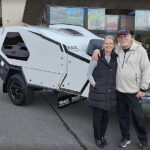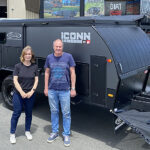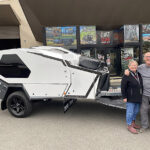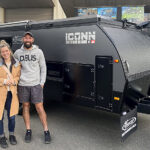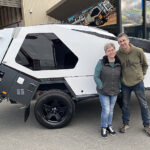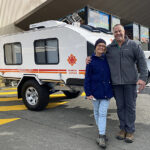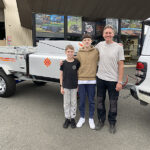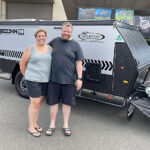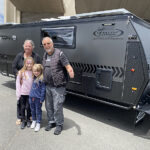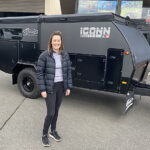Rugged and remote, the Kimberley is an iconic four-wheel drive destination, boasting impressive mountain ranges, spinifex plains, tranquil waterholes and amazing gorges. Ask any camping enthusiast about their bucket list adventures and chances are, a Kimberley adventure is right up there with the best!

The revered Gibb River Road carves through the heart of the Kimberley. It is unsealed for the best part of its 660km length, linking up to a network of side roads and tracks to access a range of national parks, gorges and coastal communities. The Gibb was originally built to service large road trains, transporting cattle to the main ports of Derby and Wyndham. While many cattle stations still operate along the Gibb, tourism draws its fair share of adventurers, seeking out the best of the region.

Starting from the south, Broome is considered as the southern gateway to the Kimberley. Of the hot spots, Cable Beach is king with its white sands and turquoise waters. Come sunset, the beach is the place to be, ranging from a beachside dinner party, playing footy with mates, hitching a ride on a camel, or just chilling out over a few drinks as the sun disappears below the horizon.

Those keen to see a few big saltwater crocs in captivity should head down to one of the Malcolm Douglas Croc farms. We visited the Wilderness Park on the outskirts of town, beyond the turnoff to Cape Leveque. Douglas was a crocodile hunter turned conservationist, renowned for his Australian outback documentaries. Sadly, he died in a car accident in 2010. The Wilderness Park has a diverse range of animals from crocs, dingoes, cassowaries, kangaroos, wallabies, euros, emus, jabirus and other furry and feathered creatures of many shapes and sizes.

The croc feeding tour starts with the handlers passing around a couple of freshwater baby crocs before moving onto a number of pools to feed salties, freshies, American alligators and a number of problem crocs, caught and relocated to the park from the wild.
Exploring the coast further, the Cape Leveque Road north of Broome leads out to the Dampier Peninsula. There are a number of free camps north of the Willie Creek Pearl Farm on the west coast via Manari Road, the most popular being Quandong Point.

Extending onto the Dampier Peninsula, the Cape Leveque Road is a patchwork quilt of road surfaces, with a common theme of corrugations on a sandy base, interspersed with creek crossing and other dips in the road surface. Reduced tyre pressures, four-wheel drive and an easy as she goes attitude will ensure you reach your destination in one piece, particularly if accompanied by a trailer.

Beagle Bay is an aboriginal community, home to the Sacred Heart church, remnants of the mission that once operated there. Mother of pearl is used extensively to decorate the main altar and the side altars are inlaid with opercula, a rare stone taken from shellfish. North of Beagle Bay, the land is Aboriginal owned and permits are required to enter many of the communities.
Middle Lagoon is home to a number of privately run campgrounds. The access track is single file only, with a mound of sand along the verges. Some sections are subject to erosion damage and others plagued with embedded rock, making for bumpy going.

We camped at Nature’s Hideaway, approximately 95km from Cape Leveque. It has both powered and unpowered sites in a bush setting, with basic hot showers and flushing toilets. Some campsites overlook the bay or ocean, with a number of basic thatched roof huts on the beach, where you can lay a swag for the ultimate beach experience. A saltwater crocodile had been seen in the bay a week earlier, but didn’t appear during our visit.
Further north, Kooljaman Resort at Cape Leveque offers a more commercial offering, with a restaurant, safari tents and cabin accommodation, amongst small powered and unpowered camper trailer plots. A lovely beach accessible via a board walk completes the experience.

There are a number of other locations on the peninsula, providing camping or day activities. One Arm Point at the top of the northern coastline cultures Trochus Shells as part of an international contract. A visitors permit available from the office opposite the shop, includes a mud map showing the points of interest and a tour of the Trochus hatchery. The tour covers the habitat of the Trochus shell, housed in a number of large water tanks. The Trochus shells are cultured in the hatchery, and then placed on the reef up to 100km offshore. The shells are harvested when they reach 75-100mm in size. The local indigenous community polish the Trochus shells as part of a 15 tonne order each year. Participants can also hand feed Barramundi.
Back on the bitumen of the Great Northern Highway out of Broome, Derby is the last major fuelling point for a while and home to the Boab Prison Tree, originally used for securing prisoners. The Boab Tree is one of the signature sights of the Kimberley, its hardy nature surviving through tropical storms, bushfires and extreme temperatures.

On the outskirts of Derby, the Gibb River Road begins its journey east. It was a surreal experience to begin our trek along this famous route after reading so much about it for many years. At the time of travel, following a late wet season, many riverside camp grounds had washed away with evidence of wide spread flood damage. Even though road works were underway to address flood damage, Bell Gorge, Mitchell Plateau and Kalumburu all remained closed. On the upside, many others were open and the Durack and Pentecost Rivers were running at a manageable levels; 700mm and 450mm respectively, all adding to the adventure.
The first leg to the turnoff of Windjana Gorge National Park is an easy run, with plenty of patches of bitumen to speed up transit, no doubt courtesy of the Blina Oil and Gas field and the Ellendale Pipe 9 Mine. The national park is easily accessed by four-wheel drive vehicles, navigating the steep entry into a shallow creek crossing.

The national park caters for generators, with two campgrounds, one specifically assigned to generator use. Bus tour operators fill the commercial operator sites at the rear of the camping ground, with some running relatively large generators to power their deep freezers and other electrical requirements; so take that into consideration when picking your site.
We propped ourselves along the front row of the generator camp which backed onto the Windjana Gorge reef wall, providing a spectacular backdrop. There were far more campers in the non-generator area, offsetting the light hum of generators with human activity. The campgrounds are well serviced by fire pits, toilets and solar showers; the latter only providing a trickle of warm water.
A couple of short walks exist in the park, the best being the Windjana Gorge walk. Cutting through a rock wall and following a sandy trail along the Lennard River, the walk leads to an open sandy bank where fresh water crocs happily sun themselves in the shallows.

The Fairfield-Leopold Road (4WD) connects Windjana Gorge to Fitzroy Crossing on an unsealed track, passing the Tunnel Creek Nature Park and the Devonian Reef Conservation Park along the way. At Tunnel Creek, you can wade into the darkness guided by torch light, to see bats, fish and fresh water crocs. The entrance to the tunnel involves clambering over large rocks requiring full mobility and waterproof footwear to aid traction on the slippery and often wet surfaces. Make sure you bring a good waterproof torch. Further south towards Fitzroy Crossing, the Fairfield-Leopold Road carves across the plains, ducking through the Devonian Reef, bordered by Boab trees.
Top up on fuel at Fitzroy Crossing if returning to the Gibb and save around 30 cents/litre for your trouble. Geikie Gorge is also worth a look. Boat rides explore the Fitzroy River and a number of scenic walks are on offer to admire the landscape.

Back on the Gibb River Road at the Windjana turnoff, our trek continues west towards the King Leopold Ranges with high granite outcrops and a sea of green in all directions. At our time of travel, Bell Gorge and Silent Grove were still closed due to flood damage. Bell Gorge is home to a pretty cascading waterfall and a number of pools to swim in.
East of the King Leopold Ranges Conservation Park, the Mornington Wildlife Sanctuary is another popular campsite south of the Gibb, run by the Australian Wildlife Conservancy.

There are plenty of fresh water swimming holes in the region, although many require a fair hike to enjoy. Galvin Gorge is the most accessible via an easy 1km walking trail.
Mt Barnett Station was our next camping destination and home to the Manning Gorge, arguably the best waterfall and swimming hole in the area. A challenging hike starts with a refreshing swim across the river, floating your clothes and cameras across in polystyrene boxes, as you swim across. Freshwater crocs sun themselves on the rocks further downstream, as was pointed out to us after we departed the water. Yikes! Continuing the adventure, hike through spinifex covered landscapes, scrambling over rocks and rock ledges to reach the water’s edge. After a swim in the icy cool waters, lying on the warm rocks is a great way to reacclimatise before beginning the return hike.

Bush camping, flushing toilets and showers service the camp, with water pumped up from the creek. Camp fires are permitted and the hosts encourage you to gather wood from within the property. Gaiters are recommended for the walks and gathering firewood, to protect the ankles from the spiky spinifex that line the tracks and possible snake sightings, although we didn’t spy any of the latter.
Kimberley-ready Touring Campers
To view our range of off road trailers, campers, hybrids and tray back campers, click HERE.
To view the second leg of our Kimberley adventure, click HERE.

